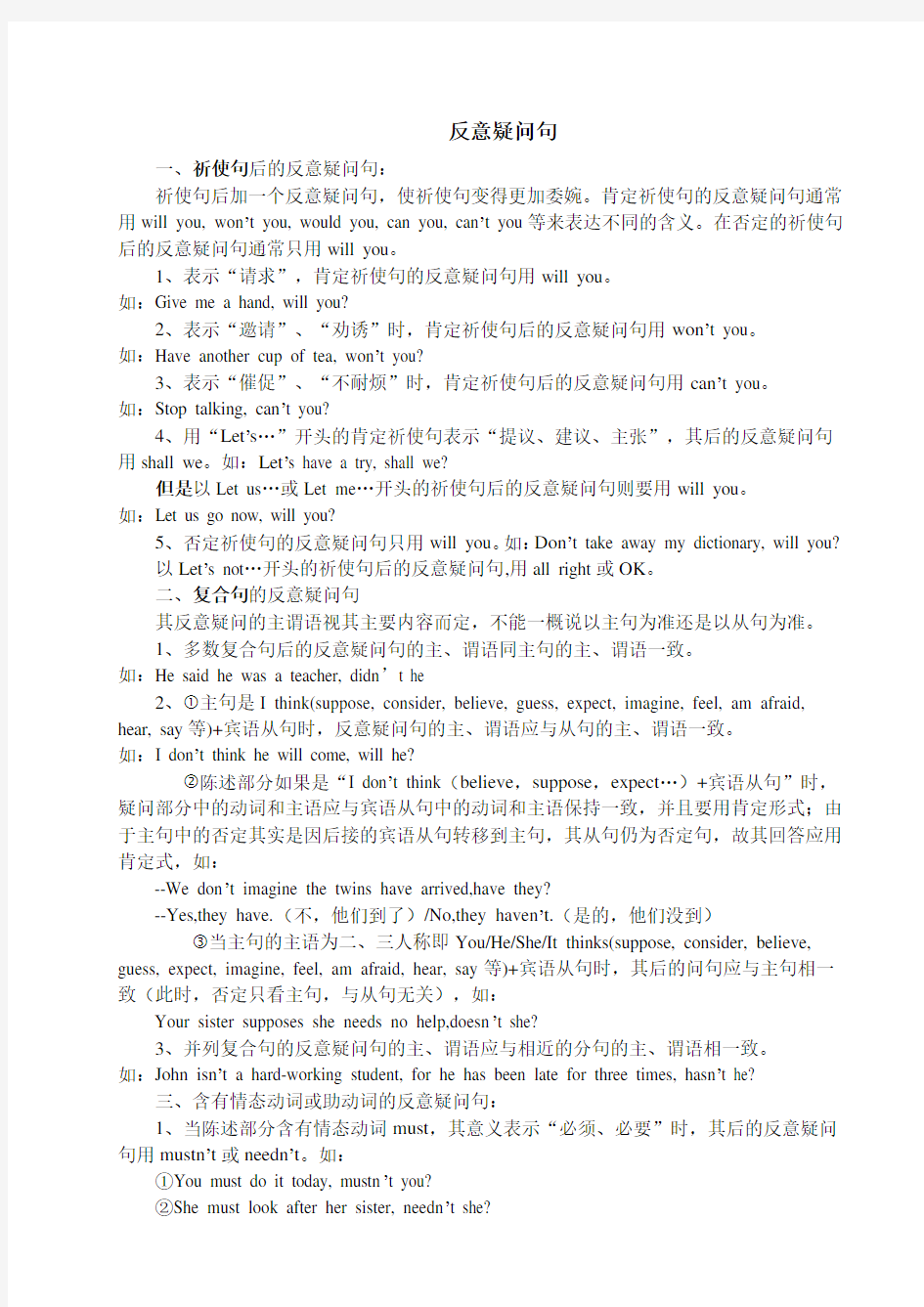反义疑问句练习题(附答案)

- 1、下载文档前请自行甄别文档内容的完整性,平台不提供额外的编辑、内容补充、找答案等附加服务。
- 2、"仅部分预览"的文档,不可在线预览部分如存在完整性等问题,可反馈申请退款(可完整预览的文档不适用该条件!)。
- 3、如文档侵犯您的权益,请联系客服反馈,我们会尽快为您处理(人工客服工作时间:9:00-18:30)。
反意疑问句
一、祈使句后的反意疑问句:
祈使句后加一个反意疑问句,使祈使句变得更加委婉。肯定祈使句的反意疑问句通常用will you, won’t you, would you, can you, can’t you等来表达不同的含义。在否定的祈使句后的反意疑问句通常只用will you。
1、表示“请求”,肯定祈使句的反意疑问句用will you。
如:Give me a hand, will you?
2、表示“邀请”、“劝诱”时,肯定祈使句后的反意疑问句用won’t you。
如:Have another cup of tea, won’t you?
3、表示“催促”、“不耐烦”时,肯定祈使句后的反意疑问句用can’t you。
如:Stop talking, can’t you?
4、用“Let’s…”开头的肯定祈使句表示“提议、建议、主张”,其后的反意疑问句用shall we。如:Let’s have a try, shall we?
但是以Let us…或Let me…开头的祈使句后的反意疑问句则要用will you。
如:Let us go now, will you?
5、否定祈使句的反意疑问句只用will you。如:Don’t take away my dictionary, will you?
以Let’s not…开头的祈使句后的反意疑问句,用all right或OK。
二、复合句的反意疑问句
其反意疑问的主谓语视其主要内容而定,不能一概说以主句为准还是以从句为准。
1、多数复合句后的反意疑问句的主、谓语同主句的主、谓语一致。
如:He said he was a teacher, didn’t he
2、①主句是I think(suppose, consider, believe, guess, expect, imagine, feel, am afraid, hear, say等)+宾语从句时,反意疑问句的主、谓语应与从句的主、谓语一致。
如:I don’t think he will come, will he?
②陈述部分如果是“I don’t think(believe,suppose,expect…)+宾语从句”时,疑问部分中的动词和主语应与宾语从句中的动词和主语保持一致,并且要用肯定形式;由于主句中的否定其实是因后接的宾语从句转移到主句,其从句仍为否定句,故其回答应用肯定式,如:
--We don’t imagine the twins have arrived,have they?
--Yes,they have.(不,他们到了)/No,they haven’t.(是的,他们没到)
③当主句的主语为二、三人称即You/He/She/It thinks(suppose, consider, believe, guess, expect, imagine, feel, am afraid, hear, say等)+宾语从句时,其后的问句应与主句相一致(此时,否定只看主句,与从句无关),如:
Your sister supposes she needs no help,doesn’t she?
3、并列复合句的反意疑问句的主、谓语应与相近的分句的主、谓语相一致。
如:John isn’t a hard-working student, for he has been late for three times, hasn’t he?
三、含有情态动词或助动词的反意疑问句:
1、当陈述部分含有情态动词must,其意义表示“必须、必要”时,其后的反意疑问句用mustn’t或needn’t。如:
①You must do it today, mustn’t you?
②She must look after her sister, needn’t she?
如果must的含义表示“一定是、想必”等推测意义时,其后的反意疑问句则要依据句中的谓语动词的时态结构采用be/have/did/do+not等相应形式。如:
①He must bee ill, isn’t he?
②You must have seen the film before, haven’t you?
2、如果陈述部分用了must have+P.P.(过去分词),但明示或暗示了过去的时间,其反意疑问句用过去时。如:
He must have seen him yesterday, didn’t he?
3、陈述部分含情态动词ought to,其后反意疑问句用oughtn’t或shouldn’t.如:
I ought to come here, oughtn’t I?
4、陈述部分含情态动词used to其后反意疑问句用usedn’t或didn’t均可。如:
Tom used to live here, usedn’t he?
5、陈述部分含有have/has/had to时,其后的反意疑问句用do的相应形式。如:
You have to go, don’t you?
但是在陈述句中用have/has/had got to来代替have/has/had to时,反意疑问句用have 的相应形式。如:
Ann has got to see a doctor, hasn’t she?
6、陈述部分有had better/would rather时,其后的反意疑问句用hadn’t/wouldn’t。如:
①You’d better not stay here, had you?
②They would rather take this one, wouldn’t they?
7、当陈述部分有dare或need时,若dare和need为实义动词疑问部分的谓语用do的适当形式;若dare和need为情态动词,疑问部分用dare和need构成。
Need与Dare 用法区别
一、need的用法
1)need可用作实义动词,意为"需要;必要",后面可接名词、动名词或动词不定式等作宾语。注意"need doing"表示被动意义,相当于need to be done。例如:
I need a dictionary, so I need to go to the bookstore. 我需要一本词典,因此我要去趟书店。How often does your hair need washing(need to be washed)? 你的头发需要多久洗一次?
2)need可用作情态动词,通常用于疑问句和否定句中,后接动词原形。这时need没有人称和数的变化,也没有时态的变化。例如:
It's only eight o'clock. Need you go so early? 才八点。你需要去这么早吗?
You needn't tell him about it as I have told him. 你不必跟他说那件事,我已经告诉他了。
3)needn't do与needn't have done的区别:
两者都表示"不必做......"。但前者表示现在或将来不必做;而后者表示"过去(本来)不必做(而事实上已经做了)"。例如:
You needn't carry the desks out of the classroom when you clean the classroom. 你打扫教室时不必把桌子搬到教室外。
You needn't have bought such a big TV as it takes too much room. 你本来不必买这么大的电视,它占据的空间太大了(而事实上已经买了)。
二、dare的用法
1)dare用作实义动词,此时其后的动词不定式可带to也可不带to,且dare有人称和数以及时态的变化。例如:
I dare to jump down from the top of the wall. 我敢从那墙头上跳下来。
